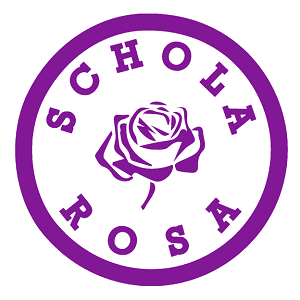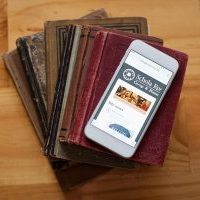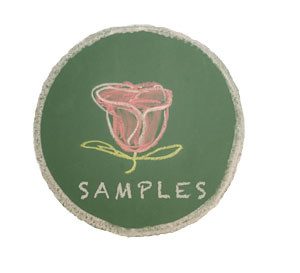Schola Rosa Preschool
In Brief . . .
- This is an "All-in-One" curriculum. This means that lesson plans, activities, printables, video, audio books, e-books, etc. are all included in the digital resource. Few additional materials are required. See more information below.
- "All-in-One" also means all subjects included: Numbers, Alphabet, Shapes, Colors, Religion, Art, and Music. See more information below.
- The curriculum is Classical, Charlotte-Mason, and Montessori in inspiration. Learn more about our philosophy of education here.
- The Preschool program is only $10 per family, for a year long, 30 unit curriculum. Most of the digital components are pre-printed and available for purchase. A few additional materials are required.
See the book lists for details about both recommended purchases and required acquisitions.
In Depth . . .
Academic Goals
- To teach the alphabet
- To teach the numbers 1-10
- To teach the colors
- To teach the shapes
- To develop large and fine motor skills
- To introduce rhythm and basic voice training
In addition to the academic goals, the preschool curriculum immerses the children in hands-on experiences that enable them to understand the world around them better. The curriculum also develops a liturgical cycle within the child’s memory by teaching lessons that integrate reading, art, and religion. Finally, the curriculum puts a special focus on good habits and virtues through Schola Rosa’s unique Virtue program which is for the whole family.
Components
Each of the 30 Units includes: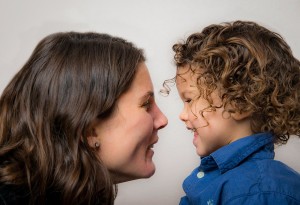
- Pre-K Lesson Each Unit – The Reading, Art, and Religion Lesson. These lessons particularly focus on the liturgical cycle and a chosen reading.
- Alphabet and Number Book – These include items such as Saint coloring pages, poetry to memorize, beginning sound pictures, shapes to count, writing practice, and “find the letter” exercises.
- Alphabet of Virtues
- Alphabet or Number Flashcards and Coloring Pages
- Instructions for Catechism and Music
- Extras - These are optional things you can do with your child to enhance the studied topic.
Class Time
Class Time is flexible per teacher and parent. Often the extra activities you choose are based on the supplies and materials you have at home or at co-op. For this reason, we have provided a suggested schedule of in-class structure broken up by “type” of activity. You will want to take an inventory of your own supplies to see what specific activities can be done and then brainstorm how to make them happen. This will take creativity and time! We are here to help, so give us a call when in doubt.
Types of In-Class Activities:
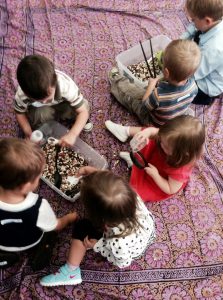 Circle Time: To get your day Started and everyone on the same page consider gathering together and explaining the day’s activities. This helps get the students excited for what is coming up and is a great time to review memory work, alphabet letter, numbers, class rules, and other such things you might want to add to your circle time.
Circle Time: To get your day Started and everyone on the same page consider gathering together and explaining the day’s activities. This helps get the students excited for what is coming up and is a great time to review memory work, alphabet letter, numbers, class rules, and other such things you might want to add to your circle time.
Name & Music: Begin Preschool time with some singing, jumping around, and learning everyone’s names. If you are doing the curriculum at home only, consider teaching your child how to sing the spelling of his or her name during this time. Music time can also include folk songs and rhythm instruments or the early portions of the Schola Rosa music program.
Story: After all the hopping around, read the story in the Preschool Lesson A. If you do not have the exact story, but something similar, feel free to substitute.
Craft Time: Now we are ready to move around again! Move into the craft that follows the story. Doing it early in the class time guarantees projects will dry before the transport home. If you are doing the curriculum at home only, then it is good to know that the earlier in the day you attempt a large project with your child, the longer your child’s patience will endure (and yours!).
Outside (or Gym) Time: The children need to be outside daily for good health and proper exercise. Build in the time directly into your class time and/or school day. After a formally structured class period, some simple play time is appropriate for helping the children relax or get out some energy, whichever is most needed. If your facility or neighborhood is not conducive to outside time, then consider using this time to teach gross motor games and teamwork and doing some basic calisthenics and gymnastics. Challenge the children to balance, jump on one foot, and race.
Snack & Story: After the energy has been expelled, children are most likely feeling like a nap. Most preschoolers still need a daily nap for good brain development and health, but if at co-op a morning nap might not be possible. You can allow the students to sit and rest while eating their snacks and enjoying another story you have picked out. This story could go along with history or science, so the little students are learning alongside their older siblings.
 Hands-on & Sensory Tubs (Free Play): Even though this is a free play time, we recommend having activity stations set up for students to find and try. This provides a creative structure to their free play. With several such stations, each child will be able to find something of interested to him or her at that time. Such activities could include:
Hands-on & Sensory Tubs (Free Play): Even though this is a free play time, we recommend having activity stations set up for students to find and try. This provides a creative structure to their free play. With several such stations, each child will be able to find something of interested to him or her at that time. Such activities could include:
- Play-Dough Station
- Puzzle Station
- Blocks or Lego Station
- Trucks and Construction Station
- Circle Reading Time Station (Picture Books for Quiet Viewing)
- Alphabet Sensory Tubs (A tub full of objects that begin with the letter of the day.)
- Daily Life Stations (kitchen items, house items, role play items – think imaginative play of the “real” world)
Rosary Circle: During this time teachers and parents can pray the rosary together and students can roam in and out of the prayer circle as they wish. You will be surprised at how many students remain sitting through the entire rosary by the end of the year!
Clean-up: Come up with small jobs that can be done by students. Divide those jobs evenly and let each student help. It could be as simple as “Now, everyone pick up two things” and as complicated as asking the older preschool students to use a dust brush or wash cloth to clean tables.
Challenges
The PreK Lessons are designed to challenge preschool students. This means that parents and teachers will need to provide assistance and hands-on help. When the lessons have been completed, even with help, a confidence is fostered within the child that gives the student more independence, adding to his or her self-worth and human dignity. The student also develops a sense of “pride in work” when he or she completes a difficult project that looks well.
Be prepared to jump in and teach students the skills they need for completing the activities, e.g. using scissors, coloring in the lines, capping glue sticks, and so on. For each skill they learn while doing a lesson, the less help the student will need on future lessons.
We are here to help, so if you have any questions or concerns, please contact us and we would be happy to assist you.

